There seems to be something wrong with that software package or how it is being used. EG: the red and blue traces in the first two plots seem identical. Perhaps they use a single FRD shot and the offset is simulated? If so where does the listening position change during this? If it were a simple and symmetrical distance calculation where would the response variations be coming from.
In the first 2 pics the blue and red line SHOULD be the same. In pic 1 the two drivers are two point sources sharing the same space (physically impossible but shown for reference). In pic 2 the only thing that changes is the vertical offset between the two drivers is changed from 0 to 60 cm to simulate a esl tweeter panel sitting on top of an esl mid panel. The individual driver responses (red and blue line) don't change but their interaction (summing) changes quite a bit due to lobing. This is why we try to keep center to center distances small between drivers playing the same frequencies at the crossover. The listening position does not change in the first 2 pics.
All subsequent graphs show the same thing but at progressively further points off axis horizontally, so in these last graphs the blue and red line DO change due to dispersion. This is why we try to keep drivers at a reasonable size vs the frequencies they are responsible for.
Read the picture descriptions, I stated explicitly what I did to make these graphs. I documented literally every single input that went into this simulation.
(P.S the charts seem to have changed since I started posting but I can't see what has changed anymore)
Nope, the graphs did not change. I made a couple of edits but didn't change any pics, only text. It takes quite a while to do the pics and the only reason I bothered posting any pics at all is because it seems this issue is not well understood by some.
Last edited:
What about the relative listening position? If you have two perfect point sources in the same space at listening height, no room or obstacles, and you move one up by 30cm and one down by 30cm the only thing that should change is the overall level. Is it possible that one stayed the same and the other was raised by 60cm?
It seems you're trying to demonstrate the existence of lobing.
By the way, the charts have come back, it must have been my browser messing around with them.
It seems you're trying to demonstrate the existence of lobing.
By the way, the charts have come back, it must have been my browser messing around with them.
Last edited:
Indeed "beaming" is a hudge problem with non segmented Electrostatic loud speakers (ESL).
My Quad ESL 57 speakers could only have one person experience a good stereo sound at a time and speaker position was critical and difficult to get right without practice (or two people), and moving the speakers to fit your position. With segmentation, my Quad ESL 63 speakers can support 3 people on a sofa, which is still terrible compared to a multiway moving coil speaker. Your points are valid, multi way Moving coil speakers have much wider sweet spots, which is why my ESL 63's are mounted on rotating plinths. Also 90' off axis you get almost no sound in free space for dipole speakers and ESL's due to the week nature of Electrostatic Forces have to be dipoles.
I agree. For HiFi with a good performance and a good recording at home I wont go back to Moving coil speakers, but for a party, or background music I would not consider an Electrostatic design for anything other than a tweeter. For portability I think an ESL speaker is impractical but STAX have attempted this more than once for headphones.
Have a look at this third party measurement of the Quad ESL 63 by stereophile.com for a square wave.
.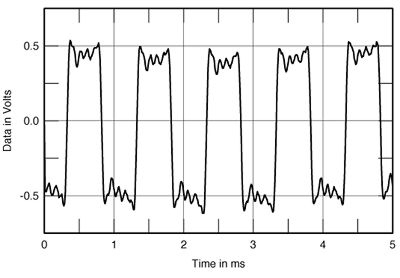
The image is also attached.
In my experience in the right position a good ESL will amaze anyone who has never heard them before, without exception, then they will say how they sound amazingly lifelike, and how the stereo imaging is unlike anything they have ever heard before from speakers, and the next comment will be how they are so BIG! Typical first next comment is could live with such big speakers? Can they have smaller electrostatics?
Yes I agree with the opinion "Loudspeaker technology is truly primitive" both for ESL and moving coil speakers, and wonder genuinely if the best solution has not yet been found.
Yes the 63's squarewave response is fantastic , did Ged ever post square responses on his speakers ...?
There is nothing unique about square waves, they are just a periodic signal and one that only tells you anything at a few frequencies. If you have an impulse response then you know what the square wave response will be for any square wave. The impulse response is valid at all frequencies. Basically if you have a compact impulse response then you will have a good square wave response. This whole thing about "square waves" is meaningless.
And since the impulse response is just the time domain representation of the frequency response, the frequency response tells you most of what you need to know. The only issue with the frequency response is that of non-minimum phase aspects which are not visible - but they are evident in the impulse response.
And since the impulse response is just the time domain representation of the frequency response, the frequency response tells you most of what you need to know. The only issue with the frequency response is that of non-minimum phase aspects which are not visible - but they are evident in the impulse response.
There is nothing unique about square waves, they are just a periodic signal and one that only tells you anything at a few frequencies. If you have an impulse response then you know what the square wave response will be for any square wave. The impulse response is valid at all frequencies. Basically if you have a compact impulse response then you will have a good square wave response. This whole thing about "square waves" is meaningless.
And since the impulse response is just the time domain representation of the frequency response, the frequency response tells you most of what you need to know. The only issue with the frequency response is that of non-minimum phase aspects which are not visible - but they are evident in the impulse response.
It would take about as much time to simply record the square wave as to write the post.
With all the blah, blah about modeling, dispersion, time alignment etc, (including from me), wouldn't it be nice to see how "the rubber meets the road."
Having a good lookin' square wave is a dramatic achievement and hard to argue with. But lacking a convincing square wave isn't a definitive put-down.... except if you have certain beliefs in time-alignment, etc.
Ben
Last edited:
My question is, are there data which show that reproduction of square waves is of audible importance? Sure, the ESL-63 sounds great, but I can think of other speakers that sound great which don't reproduce a square wave as anything visually recognizable as such.
My question is, are there data which show that reproduction of square waves is of audible importance? Sure, the ESL-63 sounds great, but I can think of other speakers that sound great which don't reproduce a square wave as anything visually recognizable as such.
We agree on that. At the Bell Labs anechoic chamber, I used to test my speakers (when they let me in on Sundays) with tone bursts... onset and offset behaviour is pretty meaningful.
The ESL folks would be laughing out loud about that test too, compared to those who shake heavy cardboard to make sound*! The graphene diaphragm people much louder!!
Ben
*without using motional feedback
Last edited:
What about the relative listening position?
The virtual mic is on the tweeter axis at 2 meters distance on all charts.
That means that technically (in reality) the blue line should have changed between graph 1 and 2 since the mid panel becomes off axis wrt the virtual mic but this spreadsheet doesn't do that. There could be a couple of reasons for that.
1. Some aspects of the spreadsheet doesn't run properly on my system (it's Excel 2003).
2. More likely the spreadsheet just doesn't calculate the dispersion effect of the offset distance but only the phase and summing difference. Usually this program is used with a virtual mic position 2 - 5 meters back (to sum properly at a real world listening distance) and small drivers are used (for example a 4 or 5 inch mid crossed to a 1 inch tweeter in very close proximity) with fairly low crossover points. In that case the amount of change in dispersion due to the offset alone is negligible since it's only a couple degrees off.
Anyway, this wasn't meant to be an in depth study of lobing or an accurate simulation of Ben's system, just a quick 3 minute sim with a spreadsheet that shows the broad strokes of the issue just fine.
There is nothing unique about square waves, they are just a periodic signal and one that only tells you anything at a few frequencies. If you have an impulse response then you know what the square wave response will be for any square wave. The impulse response is valid at all frequencies. Basically if you have a compact impulse response then you will have a good square wave response. This whole thing about "square waves" is meaningless.
And since the impulse response is just the time domain representation of the frequency response, the frequency response tells you most of what you need to know. The only issue with the frequency response is that of non-minimum phase aspects which are not visible - but they are evident in the impulse response.
Ged,
I have not been able to find much , measurement wise on your speakers, please advise as to where i can view such and Yes to Impulse response, where i do disagree with you on this is that impulse responses can be fudged not so on squarewave.
Regards,
My question is, are there data which show that reproduction of square waves is of audible importance? Sure, the ESL-63 sounds great, but I can think of other speakers that sound great which don't reproduce a square wave as anything visually recognizable as such.
Some serious Irony there SY ......... 🙄
With all the blah, blah about modeling, dispersion, time alignment etc, (including from me), wouldn't it be nice to see how "the rubber meets the road."
Ben
Modeling, dispersion, time alignment, etc are not blah blah. This is science. It has not much at all to do with "certain beliefs". You have to know how to weight the importance of all these scientific aspects and pick which ones are most important to pursue (from your own subjective standpoint) but you can't convincingly argue that the technology is primitive if you blatantly disrespect the science. I'm having a hard time trying to figure out if you even understand the scientific principles or their importance since you haven't really made any technical comments at all, only derogatory exaggerations like "shaking heavy cardboard to make sound".
Where are your measurements? Do you have any proof at all (other than subjective opinions) to back up any of your claims?
Indeed "beaming" is a hudge problem with non segmented Electrostatic loud speakers (ESL).
My Quad ESL 57 speakers could only have one person experience a good stereo sound at a time and speaker position was critical and difficult to get right without practice (or two people), and moving the speakers to fit your position. With segmentation, my Quad ESL 63 speakers can support 3 people on a sofa, which is still terrible compared to a multiway moving coil speaker. Your points are valid, multi way Moving coil speakers have much wider sweet spots, which is why my ESL 63's are mounted on rotating plinths. Also 90' off axis you get almost no sound in free space for dipole speakers and ESL's due to the week nature of Electrostatic Forces have to be dipoles.
I agree. For HiFi with a good performance and a good recording at home I wont go back to Moving coil speakers, but for a party, or background music I would not consider an Electrostatic design for anything other than a tweeter. For portability I think an ESL speaker is impractical but STAX have attempted this more than once for headphones.
Have a look at this third party measurement of the Quad ESL 63 by stereophile.com for a square wave.
.
The image is also attached.
In my experience in the right position a good ESL will amaze anyone who has never heard them before, without exception, then they will say how they sound amazingly lifelike, and how the stereo imaging is unlike anything they have ever heard before from speakers, and the next comment will be how they are so BIG! Typical first next comment is could live with such big speakers? Can they have smaller electrostatics?
Yes I agree with the opinion "Loudspeaker technology is truly primitive" both for ESL and moving coil speakers, and wonder genuinely if the best solution has not yet been found.
Square wave performance is a simple test. A recognizable square wave is readily observable in speaker performance when amplitude and phase of even just the 2nd and 3rd terms of the harmonic series are reproduced both with proper amplitude and with proper phase. Many, if not most speaker transducers, regardless of type, are capable of reproducing good approximations of square waves at certain frequencies. 1kHz square wave in and of itself is trivial; consistent square wave performance over the fundamental range for human voice and musical instruments is much greater challenge.
Very few designs rise to this challenge. This is not because speaker transducers and associated technology are primitive, but because they all obey the laws of physics. Even though ESL has low mass membrane, effective air mass loading across spectrum results in phase changes of acoustic output compared to input signal. Drivers with voice coils have additional phase changes across spectrum due to inductive reactance.
Physical performance is readily predicable, and quantifiable through measurements.
Tom Danley's Synergy horn takes hold of physics, and implements design capable of recognizable square wave over extended regions of spectrum, using only dynamic drivers and passive crossover.
A couple of pictures posted by Tom:
250Hz:

1kHz:

Really exceptional for a speaker designed for PA work, using nothing more than truly primitive loudspeaker technology.
Other posts to Tom's thread show some nice 1kH square waves too.
More recently Tom posted links to impulse response waveforms in another thread.
The measurements were taken in an informal setting; one from 1m, and the other from "listening position". These contain a wealth of information. Practice of a little information theory readily allows transformations demonstrating the frequency response of the system as captured at the recording positions. Other transformations of the information allow inspection of the reflective nature of the recording environment.
The system IR may also be used as a very good predictor of system response to an arbitrary waveform. Here are what Tom's posted impulse responses predict happen when a 1kHz square wave is played:
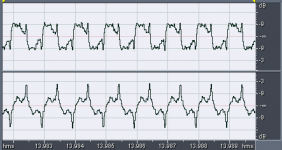
The predicted results for informal measurements are in very good agreement with Tom's 1kHz picture.
Predicted results at 250Hz show that sound projected into the room (lower traces) is much like as demonstrated in Tom's oscilloscope picture, but at the listening position the results are more typical of many multi-way speakers. In this case the temporal distortion is likely due more to room reflections than to the speaker:
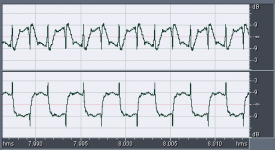
Elsewhere the speaker performance suffers like many other speakers as predicted results for Tom's speaker show at 1250Hz:
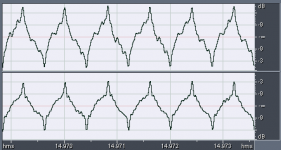
Above 1kHz the speaker performance devolves to triangle waves. In my opinion, the Synergy Horn takes primitive speaker constructs about as far as possible. Drivers are placed within 1/4 wavelengths of each other for crossover frequencies. Physical layout places lower frequencies drivers forward of higher frequency drivers, thus partially mitigating group delay issues. Crossover design is optimized to physics of speaker yet kept to few components. The net result is a speaker system with point source characteristics.
In practice, information theory not only allows for predictive analysis, but also for the construction of filters with arbitrary characteristics for both phase and amplitude. Creation of these with passive components is realistically impossible. Working in the digital domain lifts most of these restrictions.
Here are results feeding square waves into small fully active speaker with DSP:
1kHz:

67Hz:
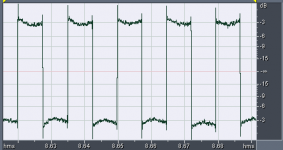
4kHz:
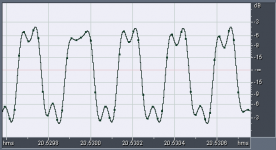
The DSP implemented fully active speaker smoothly produces square waves from about 60Hz to 4kHz. Above 4kHz too few harmonics of square wave are produced to yield square wave result.
Frequency response:
An externally hosted image should be here but it was not working when we last tested it.
Loudspeaker technology is an elegant combination of art and science. Only implementations tend to be primitive.
This is probably the easiest thing anybody can test for themselves if they can use a PC for playback (or to burn CDs), no need for second-hand "data". It's all freeware, foobar + convolver + ABX, HolmImpulse, RePhase (in fact I did my first steps in phase equalisation using just HolmI and Excel/Calc, documented in one of the HolmI threads).)My question is, are there data which show that reproduction of square waves is of audible importance? Sure, the ESL-63 sounds great, but I can think of other speakers that sound great which don't reproduce a square wave as anything visually recognizable as such.
IME the most noticable differences, timbre and spatial aspects, exist below 1kHz. With a 3-way+sub setup the differences are readily audible to pretty much anyone, with a 2-way crossed high (2kHz++) much less so... until you linearize the phase rolloff from the bass alignement as well, especially if the cutoff is 50Hz'ish and of higher order (4th-order bass reflex + subsonic filter). Wether one finds the difference important (compared to "just audible") is up to the listener.
I love testing things like amps with square waves because it jet-propels the analysis using just a single quick test that reveals a lot, at least for amps*... where we expect high-class performance (unlike what we expect from speakers).
But let's be clear. You can have a good speaker with weird square waves hitting the mic. But to have good square waves, and presumably the sound of Rene Fleming in your music room, you must have "all the ducks in a row."
By silly placement of the mic and bad choice of frequency, it is easy to produce really disgusting square waves even from a familiar speaker - as the previous post shows. But even so, the results can be meaningful and diagnostic - like those bad narrow peaks at the end of some of the previously posted square waves.
For the benefit of newbies, and to ensure there are no misunderstandings arising from the previous post, here's the take on square waves. To make a nice square wave, you need to have pretty good handling of all the frequencies from like 1/10th of the nominal frequency to 10X. If your device does that without phase screw-ups or over- and under-shoots, you have a good looking square wave. And if not, not. LIke with Rorschach ink blots, good clinicians can tell a whole lot from a square wave that means nothing to the uninitiated.
Ben
*I lied, you need two tests, one at 200 and one at 2000 Hz. But only two tests.
But let's be clear. You can have a good speaker with weird square waves hitting the mic. But to have good square waves, and presumably the sound of Rene Fleming in your music room, you must have "all the ducks in a row."
By silly placement of the mic and bad choice of frequency, it is easy to produce really disgusting square waves even from a familiar speaker - as the previous post shows. But even so, the results can be meaningful and diagnostic - like those bad narrow peaks at the end of some of the previously posted square waves.
For the benefit of newbies, and to ensure there are no misunderstandings arising from the previous post, here's the take on square waves. To make a nice square wave, you need to have pretty good handling of all the frequencies from like 1/10th of the nominal frequency to 10X. If your device does that without phase screw-ups or over- and under-shoots, you have a good looking square wave. And if not, not. LIke with Rorschach ink blots, good clinicians can tell a whole lot from a square wave that means nothing to the uninitiated.
Ben
*I lied, you need two tests, one at 200 and one at 2000 Hz. But only two tests.
Last edited:
Ged,
I have not been able to find much , measurement wise on your speakers, please advise as to where i can view such and Yes to Impulse response, where i do disagree with you on this is that impulse responses can be fudged not so on squarewave.
Regards,
My website shows a lot of measurements on my speakers, but not the impulse response, only because I don't think that most people would know what they are looking at or for. But I could post one here if that is of interest (kind of off topic actually).
But as to "fudging" impulse responses but not square waves, that's completely wrong. I can easily cheat either of them if I wanted to and with equal ease. Let's face it, when we look at measurements we are assuming that they have not be "fudged". This is equally true in all areas of science - it is so easy to do these days, if one wanted to.
My question is, are there data which show that reproduction of square waves is of audible importance? Sure, the ESL-63 sounds great, but I can think of other speakers that sound great which don't reproduce a square wave as anything visually recognizable as such.
Having produced a speaker capable of square wave down to 60Hz range, and having extended that square wave response down to <15Hz with same techniques for subwoofer, I've got some qualifications for giving an answer.
The attack of instruments with low fundamentals is more realistic for sure.
Differences become much less significant >250Hz. Greatest improvements are flat FR over lumpy or outright jagged. Very little difference between linear phase, LR2, LR4, LR8.
Capacity for working with very flat frequency response also makes it relatively easy to observe classic diffraction effects of piston behavior of drivers. Ripple of +/- 3dB is rarely audible unless you know what you are looking for. Ripple below +/1.5 dB is invisible audibly for virtually all music/speech program.
Sweet spot with flat FR is bliss with good recordings.
Early reflections have zero impact above about 200Hz when spectral balance is identical to direct sound.
Harmonic distortion and attendant intermodulation distortion increase loudness with a false sense of dynamics. Once you know what the difference is, compression drivers are relegated for people that like it way too loud, for people that insist on using tiny amplifiers, and also for their intended purpose application: PA systems.
Ben,But to have good square waves, and presumably the sound of Rene Fleming in your music room, you must have "all the ducks in a row."
Her name is spelled Renée Fleming, and now you have changed the place of her sound from "down the hall or into another room" to "in your music room", what next-the bedroom 😉?.
The problem with sound reproduction is quantifying which "ducks" are deemed most important in your specific listening environment, phase, frequency response smoothness, dynamic range, polar patterns, distortion, all are metrics which may be important or unimportant to your sense of Renée's presence.
As has been stated before, ESLs can sound outstanding in a narrow coverage area, perhaps your idea that "loudspeaker technology is truly primitive" stems from a desire to listen to speakers that sound accurate to the recording over a wider coverage area.
There are now many choices in that regard that combine excellent phase, frequency response and dynamic range with dispersion patterns appropriate to the listening environment they are designed to cover.
Art
There is so much in the above post (Barleywater) that I disagree with that I won't bother with details, I just want to note that these statements are not accepted fact, nor even common beliefs. I have no idea where they come from.
There are now many choices in that regard that combine excellent phase, frequency response and dynamic range with dispersion patterns appropriate to the listening environment they are designed to cover.
Art
Art - Thanks for this touch of sanity in an otherwise ludicrous discussion.
- Status
- Not open for further replies.
- Home
- Loudspeakers
- Multi-Way
- Loudspeaker technology is truly primitive
